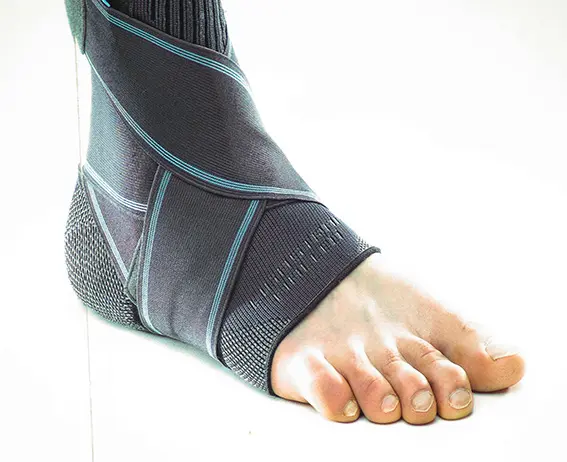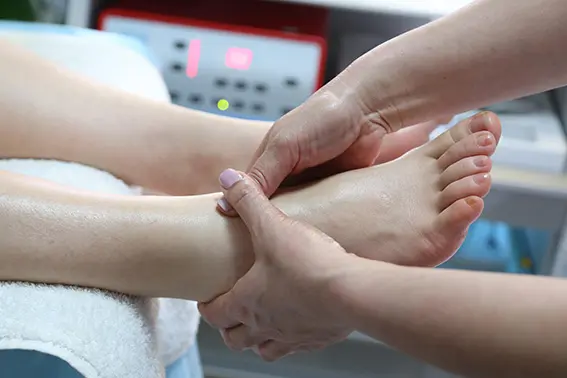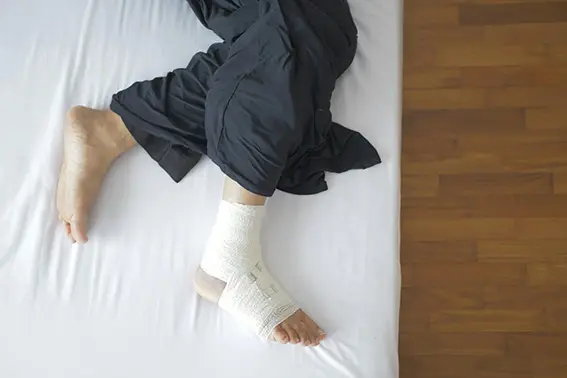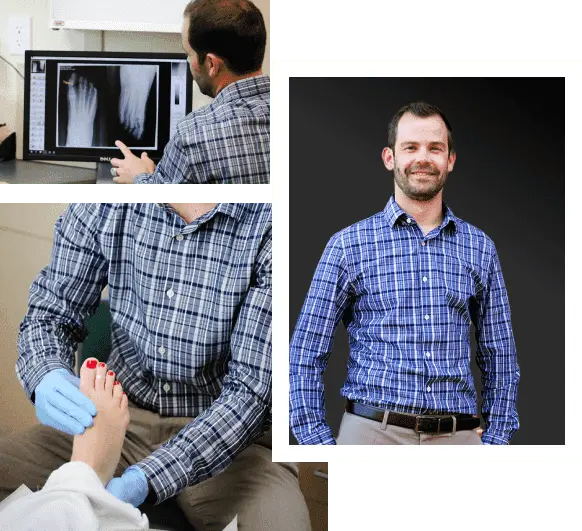Stress Fracture Foot Surgery
There’s nothing quite so frustrating as to put your heart and soul into a dance practice every waking moment, only to have the extra dance time damage your feet. Or maybe you’ve been training for a marathon, but before you reach the finish line, every step gets more painful than the last. Or maybe your tennis game leaves your feet with intense pain when they hit the court.
Sometimes, your feet just aren’t up to the tasks you give them. You get stress fractures on the heel or foot that only get worse with continued use.
So, how do you get a stress fracture? When do you see your podiatrist? What does recovery look like? And when can you return to normal training schedules?
How Do You Get a Stress Fracture on the Heel or Foot?
Your body is a machine with built-in priorities and protocols. When you train your muscles, you ask more of your muscles than you did yesterday and get microtears, which is good. Your body then rebuilds that muscle stronger than it was before to meet the new demands.
The same process works on your bones. You increase the stress load by walking, jumping, or running more than you’ve done before. The microdamage caused by the increased workload tells the body to rebuild that area stronger than it was.
If you increase the workload too fast, your body can’t repair the damage fast enough to recover between sessions. The damage accumulates, and the bones form tiny fissures or stress fractures. If you continue overloading your workouts, the cracks grow until they’re too painful to ignore.

Other contributing factors to slow healing include:
- Nutrition: Some athletes cut too many calories. Your body prioritizes nutrition, starting with vital organs. If it runs out of the building blocks necessary to rebuild the bone, the bone doesn’t recover. Increased training may not trigger adequate hunger cues to make up the difference, so you must calculate the necessary calories for your training load and stick to it. Don’t shortchange your body on a rest day when it’s doing its best to rebuild.
- Vitamin D: Your body needs Vitamin D to metabolize and use calcium. People living farther away from the equator have longer winters and less sunlight. Some people work day jobs that keep them indoors during daylight hours. You can ask your doctor to check your Vitamin D levels if you don’t feel like you recover well between training days.
- Sleep: Your entire body feels sluggish after a poor night’s sleep. Multiple nights of poor sleep can hamper your body’s ability to heal at optimal rates.
- Genetics: If your family has a history of osteoporosis, then it’s worth checking your bone health periodically. It’s easier to correct in the beginning stages than if you wait.
- Hormones: If your hormones are out of balance, it can delay healing and even make you more prone to injury.

When Do You See a Podiatrist?
As a precaution, if you put a lot of stress on your feet through your regular activities (like running, playing basketball, tennis, etc.), you may want to see a podiatrist for a wellness visit. Your doctor can assess your biomechanics, meaning the position, range of motion, flexibility, and foot function. For example, if you overpronate (your foot rolls out), your podiatrist might recommend shoes to correct the movement before you get an injury.
Beyond that, you’ll want to see your podiatrist if you quit recovering on your rest days or if putting pressure on the bone causes pain between running or dancing sessions.
When is Stress Fracture Foot Surgery Necessary?
In many cases, stress fractures never require surgery. The bone is still aligned well and will heal if you immobilize the foot and give it time. The doctor may give you a cast or walking boot, and you’ll need to rest.
Unfortunately, there are cases where the patient keeps trying to muscle through the pain. They push themselves until the fractures widen. When the bone is no longer aligned properly, and the only way it will heal is to reduce the fracture (put the pieces back together), then there are two options.
- Closed Reduction: Your podiatrist can manipulate the bone without cutting the skin. Using an X-ray to ensure proper placement, the doctor pushes the bone back into position before immobilizing it. That way, it heals in the right place.
- Surgery: Surgery is always the last resort when there are other less invasive options. However, when a closed reduction is impossible, it may be necessary to find a stress fracture surgeon. They will make a small incision and then put the bone back in place. Once the ends are aligned, the surgeon will secure the bone with a plate and some screws before closing the incision.


How Long After Stress Fracture Surgery Can You Resume Training?
This is a common question from our stress fracture surgery patients in our Mesquite, NV and St. George, UT offices.
Returning to your regular routine will take a while. You need time for the bone to mend. A small fracture can heal in four weeks with proper nutrition, calcium, Vitamin D, sleep, and rest. A more complicated break could take much longer.
Pain will be your guide. Once you get the all-clear from your doctor to remove the cast or walking boot, start walking. Your foot may hurt because it doesn’t have the same support as it did with the boot. Let your foot adjust. Be patient with yourself and stop when the pain tells you that you’ve done enough for the moment.
With persistence, you will build up a tolerance to walking, then speed walking, lifting yourself onto your toes, light jogging, and then running or dancing. If you listen to your body, you will progress steadily until you return to your sport of choice stronger than ever.
Why The Foot & Ankle Center?
Here at the Foot & Ankle Center, we want every patient to know they are seen and heard. Everyone has different goals, needs, and lifestyles. We try to find solutions that fit your unique needs in the most efficient and compassionate way possible.
Dr. Landon Cameron, DPM, FACFAS, wants injuries to heal right the first time so they don’t plague you or your children for the rest of your lives.
Being sidelined by an injury can be devastating, especially if you lead an active lifestyle, but Dr. Cameron’s focus must also encompass foot and ankle health into the future. He understands that foot care changes through the various stages of life, from childhood to your golden years. His practice serves young athletes like peewee football players and ballerinas, college and adult athletes as they compete in track and contact sports, and seasoned adults with peripheral neuropathy, bunions, and hammertoes. Dr. Cameron’s concern is always for lifelong foot and ankle health, not just what will help you in the moment.
Dr. Cameron strives to deliver the highest standard of care. He is a leading podiatrist in St. George, Utah, and Mesquite, Nevada, and is well aware of the area’s many backpacking, camping, hiking, hunting, mountain climbing, horseback riding, snowmobiling, and skiing opportunities. He will treat your stress fracture and any other foot conditions you or your family have, from sports injuries to diabetes, and get you back out on the trails as quickly and safely as possible.

On the other hand, surgery is sometimes the better option for displaced (out of alignment) bone injuries to heal right for lifelong foot and ankle functionality. As a leader in his field, Dr. Cameron is the skilled podiatric surgeon who can help you know which treatment is most appropriate given your injury, age, and stage of life. He and his compassionate medical team are with you from your first consultation to recovery with an eye to your long-term well-being. .
Dr. Cameron’s certifications/affiliations include:
- Honors graduate with a podiatric medical degree from Temple University School of Medicine
- Residency completion (Presbyterian Hospital of Greenville, Texas)
- Member of the American Podiatric Medical Association
- Member of the American College of Foot and Ankle Surgeons
Dr. Cameron has surgical privileges with the following hospitals:
- Mesa View Regional Hospital in Mesquite, NV
- St. George Regional Hospital in St. George, UT
- Cedar City Hospital in Cedar City, UT
What To Expect From Your Visit
Dr. Cameron treats many foot and heel stress fractures in his St. George and Mesquite offices. He starts by gathering a thorough injury history and performing a physical examination. If he suspects a stress fracture, he could order an X-ray or MRI to get a good look at the injury. Once he can see how the bones are positioned, he can assess whether they can heal with immobilization or if he’ll need to intercede.
Wrap Up
Stress fractures can be painful and frustrating, but they don’t have to keep you off your feet long-term. It’s always better to address unusual pain immediately before the break can get any bigger. You may not want to stop your usual activities, but pausing for medical help is far better than going through the discomfort, lengthy recovery, and surgery that may come into play if you allow your small fracture to become a big break.
We stand ready to help you recover as quickly and efficiently as possible, whatever the condition of your foot or ankle. Call our offices today at (435) 714-6996.
